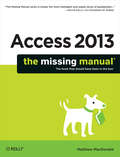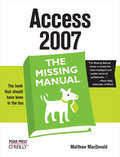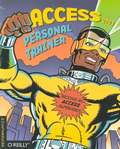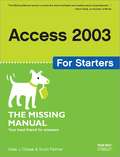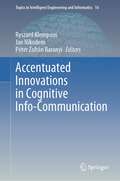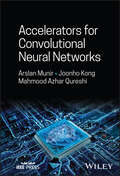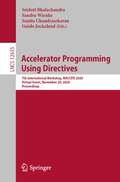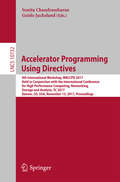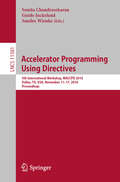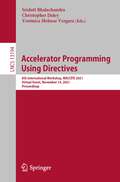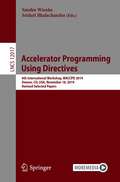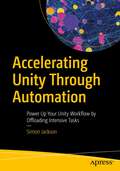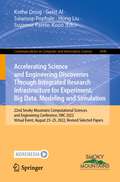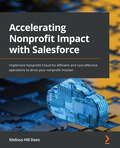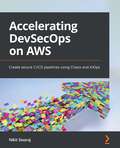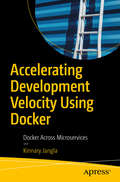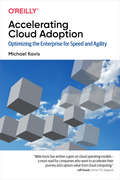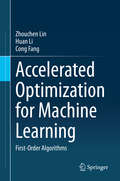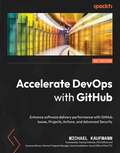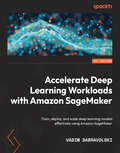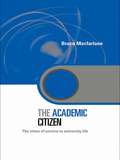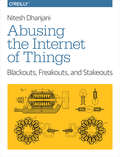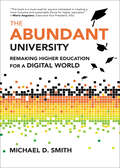- Table View
- List View
Access 2007: The Missing Manual (The\missing Manual Ser.)
by Matthew MacdonaldCompared to industrial-strength database products such as Microsoft's SQL Server, Access is a breeze to use. It runs on PCs rather than servers and is ideal for small- to mid-sized businesses and households. But Access is still intimidating to learn. It doesn't help that each new version crammed in yet another set of features; so many, in fact, that even the pros don't know where to find them all. Access 2007 breaks this pattern with some of the most dramatic changes users have seen since Office 95. Most obvious is the thoroughly redesigned user interface, with its tabbed toolbar (or "Ribbon") that makes features easy to locate and use. The features list also includes several long-awaited changes. One thing that hasn't improved is Microsoft's documentation. To learn the ins and outs of all the features in Access 2007, Microsoft merely offers online help. Access 2007: The Missing Manual was written from the ground up for this redesigned application. You will learn how to design complete databases, maintain them, search for valuable nuggets of information, and build attractive forms for quick-and-easy data entry. You'll even delve into the black art of Access programming (including macros and Visual Basic), and pick up valuable tricks and techniques to automate common tasks -- even if you've never touched a line of code before. You will also learn all about the new prebuilt databases you can customize to fit your needs, and how the new complex data feature will simplify your life. With plenty of downloadable examples, this objective and witty book will turn an Access neophyte into a true master.
Access 2007: The Missing Manual (Missing Manual)
by Matthew MacdonaldCompared to industrial-strength database products such as Microsoft's SQL Server, Access is a breeze to use. It runs on PCs rather than servers and is ideal for small- to mid-sized businesses and households. But Access is still intimidating to learn. It doesn't help that each new version crammed in yet another set of features; so many, in fact, that even the pros don't know where to find them all. Access 2007 breaks this pattern with some of the most dramatic changes users have seen since Office 95. Most obvious is the thoroughly redesigned user interface, with its tabbed toolbar (or "Ribbon") that makes features easy to locate and use. The features list also includes several long-awaited changes. One thing that hasn't improved is Microsoft's documentation. To learn the ins and outs of all the features in Access 2007, Microsoft merely offers online help.Access 2007: The Missing Manual was written from the ground up for this redesigned application. You will learn how to design complete databases, maintain them, search for valuable nuggets of information, and build attractive forms for quick-and-easy data entry. You'll even delve into the black art of Access programming (including macros and Visual Basic), and pick up valuable tricks and techniques to automate common tasks -- even if you've never touched a line of code before. You will also learn all about the new prebuilt databases you can customize to fit your needs, and how the new complex data feature will simplify your life. With plenty of downloadable examples, this objective and witty book will turn an Access neophyte into a true master.
Access 2003 Personal Trainer
by Customguide IncAs the most popular database management program on the market, Microsoft Access didn't need much improvement. But with the release of Access 2003, Microsoft managed to further enhance the way people organize, access, and share information. In this new version, Access is more capable than ever, thanks to additional features like automatic error checking, automatic property updating, and the expanded ability to import, export, and work with Extensible Markup Language (XML) data files. The number of features it offers is truly impressive--and potentially daunting. Anyone baffled by the multitude of features and functionality in Microsoft Access can get up to speed quickly with the help of Access 2003 Personal Trainer . Part of our new Personal Trainer Series, this book lets people of any technical level learn exactly what they need to know at their own pace. Unlike many consumer software tutorials that dumb down the material or present it in a confusing fashion, this book is written in a non-technical and engaging style that readers find fun, easy, and informative. This book will not only help existing users, but those who received Access as part of Microsoft Office and are now ready to dip their toe in the water. It starts with Access fundamentals and then moves on to tables, fields, queries, forms, reports, macros, and advanced topics like linking information from an external source. To best guide learning, Access 2003 Personal Trainer includes detailed diagrams, dozens of task-oriented lessons, and a fully interactive training simulation CD--everything you need to become an Access pro.
Access 2003 for Starters: Exactly What You Need to Get Started (Missing Manual)
by Scott Palmer Kate J. ChaseMaybe you got Access as part of Microsoft Office and wonder what it can do for you and your household; maybe you're a small business manager and don't have a techie on staff to train the office in Microsoft Access. Regardless, you want to quickly get your feet wet--but not get in over your head--and Access 2003 for Starters: The Missing Manual is the book to make it happen.Far more than a skimpy introduction but much less daunting than a weighty tech book, Access 2003 for Starters: The Missing Manual demystifies databases and explains how to design and create them with ease. It delivers everything you need--and nothing you don't--to use Access right away. It's your expert guide to the Access features that are most vital and most useful, and it's your trusted advisor on the more in-depth features that are best saved for developers and programmers.Access is sophisticated and powerful enough for professional developers but easy and practical enough for everyday users like you. This Missing Manual explains all the major features of Access 2003, including designing and creating databases, organizing and filtering information, and generating effective forms and reports.Bestselling authors, database designers, and programmers Scott Palmer, Ph.D., and Kate Chase are your guides for putting the world's most popular desktop data management program to work. Their clear explanations, step-by-step instructions, plenty of illustrations, and timesaving advice help you get up to speed quickly and painlessly.Whether you're just starting out or you know you've been avoiding aspects of the program and missing out on much of what it can do, this friendly, witty book will gently immerse you in Microsoft Access. Keep it handy, as you'll undoubtedly refer to it again and again.
Accentuated Innovations in Cognitive Info-Communication (Topics in Intelligent Engineering and Informatics #16)
by Ryszard Klempous Jan Nikodem Péter Zoltán BaranyiConsidering the emergence of artificial intelligence, virtual and augmented reality, 3D video and television, and holography, it is logical that we should also begin to create applications and businesses driven by these technologies. The 12 chapters of Accentuated Innovations in Cognitive Info-Communication focus on the research and development of state-of-the-art information in Cognitive Info-Communication. This interdisciplinary research area has emerged as a synergy between Info-Communication and Cognitive Sciences. It presents a synthetic, holistic combination of coherent technologies that will become increasingly important in the coming decade. It is a teaching and reference guide for VR, robotics, virtual classrooms and institutions, and medicine at the undergraduate and postgraduate levels. The discussed book is an immersive learning experience for students and teachers worldwide. In addition, it applies to other fields such as healthcare, performing arts, and television.
Accelerators for Convolutional Neural Networks
by Arslan Munir Joonho Kong Mahmood Azhar QureshiAccelerators for Convolutional Neural Networks Comprehensive and thorough resource exploring different types of convolutional neural networks and complementary accelerators Accelerators for Convolutional Neural Networks provides basic deep learning knowledge and instructive content to build up convolutional neural network (CNN) accelerators for the Internet of things (IoT) and edge computing practitioners, elucidating compressive coding for CNNs, presenting a two-step lossless input feature maps compression method, discussing arithmetic coding -based lossless weights compression method and the design of an associated decoding method, describing contemporary sparse CNNs that consider sparsity in both weights and activation maps, and discussing hardware/software co-design and co-scheduling techniques that can lead to better optimization and utilization of the available hardware resources for CNN acceleration. The first part of the book provides an overview of CNNs along with the composition and parameters of different contemporary CNN models. Later chapters focus on compressive coding for CNNs and the design of dense CNN accelerators. The book also provides directions for future research and development for CNN accelerators. Other sample topics covered in Accelerators for Convolutional Neural Networks include: How to apply arithmetic coding and decoding with range scaling for lossless weight compression for 5-bit CNN weights to deploy CNNs in extremely resource-constrained systems State-of-the-art research surrounding dense CNN accelerators, which are mostly based on systolic arrays or parallel multiply-accumulate (MAC) arrays iMAC dense CNN accelerator, which combines image-to-column (im2col) and general matrix multiplication (GEMM) hardware acceleration Multi-threaded, low-cost, log-based processing element (PE) core, instances of which are stacked in a spatial grid to engender NeuroMAX dense accelerator Sparse-PE, a multi-threaded and flexible CNN PE core that exploits sparsity in both weights and activation maps, instances of which can be stacked in a spatial grid for engendering sparse CNN accelerators For researchers in AI, computer vision, computer architecture, and embedded systems, along with graduate and senior undergraduate students in related programs of study, Accelerators for Convolutional Neural Networks is an essential resource to understanding the many facets of the subject and relevant applications.
Accelerator Programming Using Directives: 7th International Workshop, WACCPD 2020, Virtual Event, November 20, 2020, Proceedings (Lecture Notes in Computer Science #12655)
by Sridutt Bhalachandra Sandra Wienke Sunita Chandrasekaran Guido JuckelandThis book constitutes the proceedings of the 7th International Workshop on Accelerator Programming Using Directives, WACCPD 2020, which took place on November 20, 2021. The workshop was initially planned to take place in Atlanta, GA, USA, and changed to an online format due to the COVID-19 pandemic.WACCPD is one of the major forums for bringing together users, developers, and the software and tools community to share knowledge and experiences when programming emerging complex parallel computing systems. The 5 papers presented in this volume were carefully reviewed and selected from 7 submissions. They were organized in topical sections named: OpenMP; OpenACC; and Domain-specific Solvers.
Accelerator Programming Using Directives: 4th International Workshop, WACCPD 2017, Held in Conjunction with the International Conference for High Performance (9783319748962 #10732)
by Sunita Chandrasekaran Guido JuckelandThis book constitutes the refereed post-conference proceedings of the 4th International Workshop on Accelerator Programming Using Directives, WACCPD 2017, held in Denver, CO, USA, in November 2017. <P><P> The 9 full papers presented have been carefully reviewed and selected from 14 submissions. The papers share knowledge and experiences to program emerging complex parallel computing systems. They are organized in the following three sections: applications; environments; and program evaluation.
Accelerator Programming Using Directives: 5th International Workshop, WACCPD 2018, Dallas, TX, USA, November 11-17, 2018, Proceedings (Lecture Notes in Computer Science #11381)
by Sunita Chandrasekaran Guido Juckeland Sandra WienkeThis book constitutes the refereed post-conference proceedings of the 5th International Workshop on Accelerator Programming Using Directives, WACCPD 2018, held in Dallas, TX, USA, in November 2018. The 6 full papers presented have been carefully reviewed and selected from 12 submissions. The papers share knowledge and experiences to program emerging complex parallel computing systems. They are organized in the following three sections: applications; using openMP; and program evaluation.
Accelerator Programming Using Directives: 8th International Workshop, WACCPD 2021, Virtual Event, November 14, 2021, Proceedings (Lecture Notes in Computer Science #13194)
by Christopher Daley Sridutt Bhalachandra Verónica Melesse VergaraThis book constitutes the proceedings of the 8th International Workshop on Accelerator Programming Using Directives, WACCPD 2021, which took place in November 2021. The conference was held as hybrid event. WACCPD is one of the major forums for bringing together users, developers, and the software and tools community to share knowledge and experiences when programming emerging complex parallel computing systems. The 7 papers presented in this volume were carefully reviewed and selected from 11 submissions. They were organized in topical sections named: Directive Alternatives; Directive Extensions; and Directive Case Studies.
Accelerator Programming Using Directives: 6th International Workshop, WACCPD 2019, Denver, CO, USA, November 18, 2019, Revised Selected Papers (Lecture Notes in Computer Science #12017)
by Sandra Wienke Sridutt BhalachandraThis book constitutes the refereed post-conference proceedings of the 6th International Workshop on Accelerator Programming Using Directives, WACCPD 2019, held in Denver, CO, USA, in November 2019.The 7 full papers presented have been carefully reviewed and selected from 13 submissions. The papers share knowledge and experiences to program emerging complex parallel computing systems. They are organized in the following three sections: porting scientific applications to heterogeneous architectures using directives; directive-based programming for math libraries; and performance portability for heterogeneous architectures.
Accelerating Unity Through Automation: Power Up Your Unity Workflow by Offloading Intensive Tasks
by Simon JacksonBuilding games with Unity is hard enough without having to stand up and go and make a coffee each time you want to just build your project or find out days/weeks down the line that some change you made while building your dream has incurred a debt that means your project cannot be built for one of your target platforms without a lot of rework.Through automation, many of these hardships can be detected early and free up time and stress by monitoring your project as it is being created, identify risks and issues as you write the code, and free up your machine while lengthy build processes are running. The change might be hard, but once setup, it will give you peace of mind that everything you create will run, updates will be automatically managed, and your players are less likely to be drafting one-star reviews on your next publication.What You Will Learn• Build the automation of your dreams to accelerate your project• Get detailed examples for generating workflows tailored to your needs• Learn to save time and money by having a backend work for youWho Is This Book ForDevelopers having experience with Unity and interested in learning about (with no foreknowledge in) automation will greatly benefit from this book.
Accelerating Science and Engineering Discoveries Through Integrated Research Infrastructure for Experiment, Big Data, Modeling and Simulation: 22nd Smoky Mountains Computational Sciences and Engineering Conference, SMC 2022, Virtual Event, August 23–25, 2022, Revised Selected Papers (Communications in Computer and Information Science #1690)
by Kothe Doug Geist Al Swaroop Pophale Hong Liu Suzanne Parete-KoonThis book constitutes the refereed proceedings of the 22nd Smoky Mountains Computational Sciences and Engineering Conference on Accelerating Science and Engineering Discoveries Through Integrated Research Infrastructure for Experiment, Big Data, Modeling and Simulation, SMC 2022, held virtually, during August 23–25, 2022. The 24 full papers included in this book were carefully reviewed and selected from 74 submissions. They were organized in topical sections as follows: foundational methods enabling science in an integrated ecosystem; science and engineering applications requiring and motivating an integrated ecosystem; systems and software advances enabling an integrated science and engineering ecosystem; deploying advanced technologies for an integrated science and engineering ecosystem; and scientific data challenges.
Accelerating Nonprofit Impact with Salesforce: Implement Nonprofit Cloud for efficient and cost-effective operations to drive your nonprofit mission
by Melissa Hill DeesDrive digital transformation for nonprofits with well-organized volunteer management, donor engagement, fundraising, and grantmaking using the intelligent and powerful capabilities of Salesforce Nonprofit CloudKey FeaturesImplement NPSP modules to scale varied business operations in nonprofitsAdminister and automate business processes and tasks with NPSP for nonprofitsCustomize and extend the standard functionalities of Nonprofit Cloud and NPSP as per client needs, resources, and critical outcomesBook DescriptionSalesforce Nonprofit Cloud enables a 360-degree view of people related to your nonprofit to connect fundraising, program management, and grantmaking. With a single, unified view of every interaction with constituents, nonprofits can create strong relationships with the community and streamline internal processes. The book starts by covering the tools and features that make up Nonprofit Cloud, helping you understand their standard functionalities and how Nonprofit Success Pack's (NPSP) data architecture is critical to implementation. You'll learn how the Nonprofit Cloud Program Management Module can connect your programs, automate case management, and track client progress. Next, you'll explore the tools for creating a change management process to increase user adoption. Moving ahead, you'll understand how to configure necessary permissions for NPSP administration and explore how declarative tools help better align the goals of a nonprofit organization. Toward the concluding chapters, you'll cover customizations, deployment, custom reports, and dashboards for fundraising analytics, as well as best practices for data management to maintain its integrity. By the end of this Salesforce book, you'll be able to build and configure the Nonprofit Cloud for a variety of use cases to achieve maximum social impact with the least amount of technical debt.What you will learnImplement various components and modules in Nonprofit CloudImplement tools for grantmaking, program management, and case managementExtend the standard functionalities of Nonprofit Cloud and NPSPIdentify and use success metrics to prioritize goals and outcomes for implementationExplore the tools that Nonprofit Cloud offers for testing and deploymentBuild custom reports and dashboards for NPSP and use Tableau dashboard starters for fundraising analyticsUnderstand best practices for data management to maintain data accuracy and data integrityWho this book is forThis book is for technical consultants, functional consultants, and Salesforce architects who are working with nonprofit organizations and want to implement different functionalities within Nonprofit Cloud and NPSP optimally for business processes and tasks in their organizations. Salesforce administrator skills and overall proficiency with Salesforce are required to get the most out of this book.
Accelerating DevSecOps on AWS: Create secure CI/CD pipelines using Chaos and AIOps
by Nikit SwarajBuild high-performance CI/CD pipelines that are powered by AWS and the most cutting-edge tools and techniquesKey FeaturesMaster the full AWS developer toolchain for building high-performance, resilient, and powerful CI/CD pipelinesGet to grips with Chaos engineering, DevSecOps, and AIOps as applied to CI/CDEmploy the latest tools and techniques to build a CI/CD pipeline for application and infrastructureBook DescriptionContinuous integration and continuous delivery (CI/CD) has never been simple, but these days the landscape is more bewildering than ever; its terrain riddled with blind alleys and pitfalls that seem almost designed to trap the less-experienced developer. If you're determined enough to keep your balance on the cutting edge, this book will help you navigate the landscape with ease. This book will guide you through the most modern ways of building CI/CD pipelines with AWS, taking you step-by-step from the basics right through to the most advanced topics in this domain.The book starts by covering the basics of CI/CD with AWS. Once you're well-versed with tools such as AWS Codestar, Proton, CodeGuru, App Mesh, SecurityHub, and CloudFormation, you'll focus on chaos engineering, the latest trend in testing the fault tolerance of your system. Next, you'll explore the advanced concepts of AIOps and DevSecOps, two highly sought-after skill sets for securing and optimizing your CI/CD systems. All along, you'll cover the full range of AWS CI/CD features, gaining real-world expertise.By the end of this AWS book, you'll have the confidence you need to create resilient, secure, and performant CI/CD pipelines using the best techniques and technologies that AWS has to offer.What you will learnUse AWS Codestar to design and implement a full branching strategyEnforce Policy as Code using CloudFormation Guard and HashiCorp SentinelMaster app and infrastructure deployment at scale using AWS Proton and review app code using CodeGuruDeploy and manage production-grade clusters using AWS EKS, App Mesh, and X-RayHarness AWS Fault Injection Simulator to test the resiliency of your appWield the full arsenal of AWS Security Hub and Systems Manager for infrastructure security automationEnhance CI/CD pipelines with the AI-powered DevOps Guru serviceWho this book is forThis book is for DevOps engineers, engineering managers, cloud developers, and cloud architects. Basic experience with the software development life cycle, DevOps, and AWS is all you need to get started.
Accelerating Development Velocity Using Docker: Docker Across Microservices
by Kinnary JanglaDiscover how a software engineer can leverage Docker in order to expedite development velocity. This book focuses on the fundamental concepts this program is built upon and explores how it can help you get your services up and running inside Docker containers. You'll also review tips on how to debug microservices applications that run inside Docker containers.Tech companies are now developing complex softwares that are comprised of multiple services running on different platforms, and Docker has become an essential part of coordinating the communication between these services and platforms. This book addresses problems caused by drifting microservices, debugging across services, inconsistent environments across machines, and coordinating development of machine learning systems between a team of developers, etc. Accelerating Development Velocity Using Docker puts you on the path to transforming your complex systems into more efficient ones.What You'll LearnSetup Docker and employ quick solutions to road blocksReview challenges associated with debugging microservices that sit behind a complex applicationLeverage Docker features to seamlessly get multiple microservices up and runningDebug inside a Docker containerReview advanced use cases of Docker that can help consistency of development environments· Who This Book Is ForIdeal for new to mid-level infrastructure engineers who want to learn how to make their development environments efficient across their and cross teams, or for students who aspire to learn basics of how to debug distributed systems and how to develop efficient applications.
Accelerating Cloud Adoption
by Michael KavisMany companies move workloads to the cloud only to encounter issues with legacy processes and organizational structures. How do you design new operating models for this environment? This practical book shows IT managers, CIOs, and CTOs how to address the hardest part of any cloud transformation: the people and the processes.Author Mike Kavis (Architecting the Cloud) explores lessons learned from enterprises in the midst of cloud transformations. Youâ??ll learn how to rethink your approach from a technology, process, and organizational standpoint to realize the promise of cost optimization, agility, and innovation that public cloud platforms provide.Learn the difference between working in a data center and operating in the cloudExplore patterns and anti-patterns for organizing cloud operating modelsGet best practices for making the organizational change required for a move to the cloudUnderstand why site reliability engineering is essential for cloud operationsImprove organizational performance through value stream mapping
Accelerated Optimization for Machine Learning: First-Order Algorithms
by Zhouchen Lin Huan Li Cong FangThis book on optimization includes forewords by Michael I. Jordan, Zongben Xu and Zhi-Quan Luo. Machine learning relies heavily on optimization to solve problems with its learning models, and first-order optimization algorithms are the mainstream approaches. The acceleration of first-order optimization algorithms is crucial for the efficiency of machine learning. Written by leading experts in the field, this book provides a comprehensive introduction to, and state-of-the-art review of accelerated first-order optimization algorithms for machine learning. It discusses a variety of methods, including deterministic and stochastic algorithms, where the algorithms can be synchronous or asynchronous, for unconstrained and constrained problems, which can be convex or non-convex. Offering a rich blend of ideas, theories and proofs, the book is up-to-date and self-contained. It is an excellent reference resource for users who are seeking faster optimization algorithms, as well as for graduate students and researchers wanting to grasp the frontiers of optimization in machine learning in a short time.
Accelerate DevOps with GitHub: Enhance software delivery performance with GitHub Issues, Projects, Actions, and Advanced Security
by Michael Kaufmann Thomas Dohmke Donovan BrownTake your DevOps and DevSecOps game to the next level by leveraging the power of the GitHub toolset in practiceKey FeaturesRelease software faster and with confidenceIncrease your productivity by spending more time on software delivery and less on fixing bugs and administrative tasksDeliver high-quality software that is more stable, scalable, and secureBook DescriptionThis practical guide to DevOps uses GitHub as the DevOps platform and shows how you can leverage the power of GitHub for collaboration, lean management, and secure and fast software delivery. The chapters provide simple solutions to common problems, thereby helping teams that are already on their DevOps journey to further advance into DevOps and speed up their software delivery performance. From finding the right metrics to measure your success to learning from other teams' success stories without merely copying what they've done, this book has it all in one place. As you advance, you'll find out how you can leverage the power of GitHub to accelerate your value delivery – by making work visible with GitHub Projects, measuring the right metrics with GitHub Insights, using solid and proven engineering practices with GitHub Actions and Advanced Security, and moving to event-based and loosely coupled software architecture. By the end of this GitHub book, you'll have understood what factors influence software delivery performance and how you can measure your capabilities, thus realizing where you stand in your journey and how you can move forward.What you will learnEffectively measure software delivery performanceAdopt DevOps and lean management techniques in your teamsPlan, track, and visualize your work using GitHub Issues and ProjectsUse continuous delivery with GitHub Actions and PackagesScale quality through testing in production and chaos engineering“Shift left” security and secure your entire software supply chainUse DevSecOps practices with GitHub Advanced SecuritySecure your code with code scanning, secret scanning, and DependabotWho this book is forThis book is for developers, solutions architects, DevOps engineers, and SREs, as well as for engineering or product managers who want to enhance their software delivery performance. Whether you're new to DevOps, already have experience with GitHub Enterprise, or come from a platform such as Azure DevOps, Team Foundation Server, GitLab, Bitbucket, Puppet, Chef, or Jenkins but struggle to achieve maximum performance, you'll find this book beneficial.
Accelerate Deep Learning Workloads with Amazon SageMaker: Train, deploy, and scale deep learning models effectively using Amazon SageMaker
by Vadim DabravolskiPlan and design model serving infrastructure to run and troubleshoot distributed deep learning training jobs for improved model performance.Key FeaturesExplore key Amazon SageMaker capabilities in the context of deep learningTrain and deploy deep learning models using SageMaker managed capabilities and optimize your deep learning workloadsCover in detail the theoretical and practical aspects of training and hosting your deep learning models on Amazon SageMakerBook DescriptionOver the past 10 years, deep learning has grown from being an academic research field to seeing wide-scale adoption across multiple industries. Deep learning models demonstrate excellent results on a wide range of practical tasks, underpinning emerging fields such as virtual assistants, autonomous driving, and robotics. In this book, you will learn about the practical aspects of designing, building, and optimizing deep learning workloads on Amazon SageMaker. The book also provides end-to-end implementation examples for popular deep-learning tasks, such as computer vision and natural language processing. You will begin by exploring key Amazon SageMaker capabilities in the context of deep learning. Then, you will explore in detail the theoretical and practical aspects of training and hosting your deep learning models on Amazon SageMaker. You will learn how to train and serve deep learning models using popular open-source frameworks and understand the hardware and software options available for you on Amazon SageMaker. The book also covers various optimizations technique to improve the performance and cost characteristics of your deep learning workloads.By the end of this book, you will be fluent in the software and hardware aspects of running deep learning workloads using Amazon SageMaker.What you will learnCover key capabilities of Amazon SageMaker relevant to deep learning workloadsOrganize SageMaker development environmentPrepare and manage datasets for deep learning trainingDesign, debug, and implement the efficient training of deep learning modelsDeploy, monitor, and optimize the serving of DL modelsWho this book is forThis book is relevant for ML engineers who work on deep learning model development and training, and for Solutions Architects who design and optimize end-to-end deep learning workloads. It assumes familiarity with the Python ecosystem, principles of Machine Learning and Deep Learning, and basic knowledge of the AWS cloud.
The Academic Citizen: The Virtue of Service in University Life (Key Issues in Higher Education)
by Bruce MacfarlaneWith increasing focus on excellence in research and teaching, the service role of the individual academic is often neglected. This book calls for greater recognition of this important aspect of academic life, highlighting the importance of mentoring, committee work and pastoral care in the daily running of universities. Drawing from extensive examples from models around the world, The Academic Citizen points to the benefits of effective communication with colleagues in the faculty, across the university and in corresponding faculties across the world, as well as those in maintaining positive associations with the wider world.
Academic Bildung in Net-based Higher Education: Moving beyond learning (Routledge Research in Higher Education)
by Trine Fossland Helle Mathiasen Mariann SolbergThe explosive emergence of net-based learning in higher education brings with it new possibilities and constraints in teaching and learning environments.This edited collection considers how the concept of Academic Bildung - a term suggesting a personal educational process beyond actual educational learning - can be applied to net-based higher education. The book is drawing on Scandinavian research to address the topic from both a theoretical and practical standpoint.Chapters explore the facilitation of online courses and argue how and why universities should involve dimensions of Academic Bildung on both a strategic and technological pedagogical content level. The book is structured in three parts: Part I frames the current state of net-based learning and introduces Bildung as a concept; Part II contains a set of four case studies in Norway, Sweden and Denmark, also including a fifth study that looks at Scandinavian approaches to teaching and learning in comparison with data from the USA, the UK, Australia and Canada; Part III provides a synthesis of theories and cases to examine whether a Scandinavian orientation can be discerned. Contributions suggest that in order to address one of the fundamental functions of higher education, the ability to produce new knowledge, the Academic Bildung of the students has to be in focus. Grounded in theoretical and empirical discussion, this book will appeal to researchers and academics in the field of higher education as well as personnel who work with teaching and learning with technology, and academics interested in the question of Academic Bildung.
Abusing the Internet of Things: Blackouts, Freakouts, and Stakeouts
by Nitesh DhanjaniThe upcoming IoT age will blur the line between our physical and online lives. Attacks targeting our online spaces will put our physical security at risk. Traditionally, the attack vectors to our fundamental luxuries have required physical tampering, mostly because access to the infrastructure has been limited from the Internet. This is about to change with the upcoming disruption caused by a future with billions of "things" connected to the Internet.This book takes a fascinating look into abusing the most popular IoT-based devices already available in the market. You'll learn how a simple attack can cause a perpetual blackout targeting LED lightbulbs, how bad security decisions have grossly violated the physical safety and privacy of families, and how the insecurity of powerful electric vehicles can put your life at risk.The goal of this book is to demonstrate tangible risk in IoT devices that we're going to depend on more and more as time progresses. Once we begin to understand the cause of actual security vulnerabilities in devices today, we will begin to set the path for a future that will help us enable these devices to securely enhance and augment our lives.The stakes are high. Malicious attackers are already hard at work uncovering and exploiting these security defects and they will continue to find crafty avenues to abuse their knowledge every way they can. These attackers span the spectrum of curious college students to sophisticated private and state sponsored criminal gangs that are interested in terrorizing individuals and populations. The impact of security vulnerabilities in IoT devices can lead to mass compromise of privacy and cause physical harm.
Abuse: An Encyclopedia Of Causes, Consequences, And Treatments
by Rosemarie SkaineAbuse, a key theme of health education curricula, is also a major issue faced by many segments of society. Intended for high school students as well as undergraduates and the general reader, this comprehensive encyclopedia explores abuse in all its forms--physical, sexual, emotional, and verbal--among a variety of age and demographic groups from children to the elderly to the disabled. It sheds light on causes and symptoms of abuse, examines lasting impacts, and suggests avenues for prevention and treatment. <P><P> Specific topics of concern to a secondary school audience include bullying and cyberbullying; abuse of those in same-sex relationships; and sexual abuse through rape, date rape, incest, and sexting. Elder abuse, which has become of greater concern as our society ages, is covered, as are domestic abuse, child abuse, and abduction. Through up-to-date entries by expert contributors, readers will learn about the causes and results of specific types of abuse, as well as their legal and sociological dimensions. The title will also serve as a gateway to further study--and as a resource for readers seeking help.
The Abundant University: Remaking Higher Education for a Digital World
by Michael D. SmithWhy our current system of higher education is financially and morally unsustainable and how to address the crisis with the creative implementation of digital technologies.For too long, our system of higher education has been defined by scarcity: scarcity in enrollment, scarcity in instruction, and scarcity in credentials. In addition to failing students professionally, this system has exacerbated social injustice and socioeconomic stratification across the globe. In The Abundant University, Michael D. Smith argues that the only way to create a financially and morally sustainable higher education system is by embracing digital technologies for enrolling, instructing, and credentialing students—the same technologies that we have seen create abundance in access to resources in industry after industry.The Abundant University explains how we got our current system, why it&’s such an expensive, inefficient mess, and how a system based on exclusivity cannot foster inclusivity. Smith challenges the resistance to digital technologies that we have already seen among numerous institutions, citing the examples of faculty resistance toward digital learning platforms. While acknowledging the understandable self-preservation instinct of our current system of residential education, Smith makes a case for how technology can engender greater educational opportunity and create changes that will benefit students, employers, and society as a whole.
